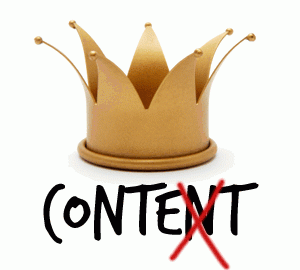In B2B Sales, Context is Everything
 Content. Ever since the Worldwide Web became an emerging marketplace for products and trade, companies began throwing content - scattershot - onto their websites to fill the void. Its relevance was often questionable; its value to the sales cycle, perhaps, non-existent. That type of content may have once been considered “king,” but it’s been toppled from its throne. Content means virtually nothing without proper context.
Content. Ever since the Worldwide Web became an emerging marketplace for products and trade, companies began throwing content - scattershot - onto their websites to fill the void. Its relevance was often questionable; its value to the sales cycle, perhaps, non-existent. That type of content may have once been considered “king,” but it’s been toppled from its throne. Content means virtually nothing without proper context.As the old axiom suggests, timing may indeed be everything. It certainly is the key element of context in the customer sales cycle. Knowing not only what they want, but what your customers need to see, hear and learn –and when—throughout the discovery, research and purchase phases is critical. Tailoring your content to each one of those milestones is essential.
Anticipating Your Customers’ Needs
Effective context in B2B sales translates into understanding your clients’ needs and how they change, every step of the way. HubSpot’s recently launched service, Signals, is built upon this premise. Signals allows you to create a better and personalized customer plan. Instead of cold-calling leads and demanding a few minutes of their time, Signals allows you to check if your timing is right. The service alerts salespeople when a customer demonstrates interest. The specific situation or mindset of your customer is the context. Without it, the ability to provide appropriate product content, make a relevant conversion or drive leads down the sales funnel is severely limited.
Context marketing is simply a more refined distillation of old hit-and-miss methods of getting to know your customers and understanding their needs. It’s arguably the future of effective Sales & Marketing. Here’s why you should start implementing it today.
Relationships Come Before ROI
Worried about your ROI? Many executives are. The smarter ones, however, understand that this new economy hinges on lasting customer relationships and personalized customer service. The “Me Generation” demands that you treat customers differently, that you should listen more and consider the context before delivering the message.
Context marketing can help forge better customer relationships because it’s more targeted. It’s relevant marketing because you’re delivering valuable information and resources to the customer when they want it, when they need it.
Timely Sales & Marketing Initiatives
An effective context marketing strategy factors in relevant data about a target customer. If you have a B2B lead who just downloaded a product guide last week, you’re able to identify that interest and send your potential customer richly-targeted content immediately. Now. Not two days or a week later. And just as important, not a week too early when your lead is not yet ready to hear your value pitch.
Timing is indeed everything in B2B sales and marketing. Think about it: people are drowning in a sea of information. You have to throw them a lifeline at just the right time.
Ready to make your sales growth predictable, sustainable and scalable? Here are some context marketing strategies you can implement:
Using Smart Forms for Higher Conversion Rates
Forms are oft-overlooked marketing assets. But turn them into smart forms and you’ll see your conversion rates shooting up.
Smart forms, put simply, are forms on your landing pages capable of detecting whether someone has previously provided the customer information you’ve requested. They won’t ask site visitors questions that have already been answered. But they are proven to glean additional valuable information.
More new information translates to fresh insights about your leads, and eventually to improved conversion rates.
Using Smart or Dynamic Calls-to-Action.
The beauty of dynamic CTAs is that they adjust to different users. They automatically align with your prospect depending on which stage they are at in the sales cycle. So prospects ready to buy are shown a top-of-the-funnel CTA, while those not ready to talk to a salesperson are shown a bottom-of-the-funnel CTA.
You can also set other types of criteria. Dynamic CTAs can appropriately respond to users based on their location, activity or behavior, business type or industry. These are truly impressive tools for creating a personalized customer experience.
Personalized Email Content
Start with a targeted list of contacts. Segmenting your email database into smaller groups allows you to craft a more personalized message that’s guaranteed to grab your recipient’s attention. You can, for instance, create a separate group of early subscribers to avoid bombarding them with messages. Here are other criteria you might want to consider when segmenting your database: geographic area, purchase history, long-time or power users.
And don’t neglect to reward your power users. Send them bonuses or special offers via email to show how much you appreciate their continued support.
Effective content? Context is everything.
Simply think of it as superior pre-, concurrent and post-Customer Service. When you are finely attuned to the needs, desires and demands of your customers, you will not only close a sale, you will be establishing a valuable ongoing relationship with them.

.png)
.png)




